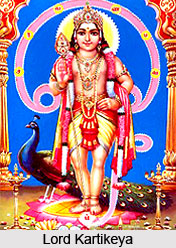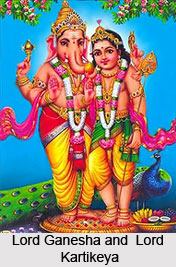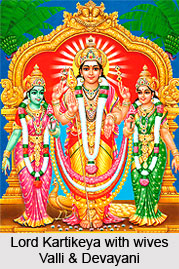 The origin of Lord Kartikeya has been explained in various ancient texts and epics. Most of the versions are almost similar, with minor changes in the details. Lord Kartikeya, also known as Murugan, Skanda, Subrahmanya, Senthil etc, is a Hindu Deity. It is widely believed that Lord Kartikeya is the son of Lord Shiva and Goddess Parvati. Lord Ganesha is his younger brother and Saraswati and Lakshmi are his sisters. His other names are Sanmuga, Shadanana, Shantakumar, Saravana, Guha, Senthil, Sanmukha, Arumugam, Swaminatha, Kumaran, Guruhuha and Velan. Lord Kartikeya is the God of War and Victory, was created by all the gods, in order to vanquish the demons, particularly the cruel demon Taraka Asura. There are several accounts and legends related to the origin of Lord Kartikeya. These are discussed below-
The origin of Lord Kartikeya has been explained in various ancient texts and epics. Most of the versions are almost similar, with minor changes in the details. Lord Kartikeya, also known as Murugan, Skanda, Subrahmanya, Senthil etc, is a Hindu Deity. It is widely believed that Lord Kartikeya is the son of Lord Shiva and Goddess Parvati. Lord Ganesha is his younger brother and Saraswati and Lakshmi are his sisters. His other names are Sanmuga, Shadanana, Shantakumar, Saravana, Guha, Senthil, Sanmukha, Arumugam, Swaminatha, Kumaran, Guruhuha and Velan. Lord Kartikeya is the God of War and Victory, was created by all the gods, in order to vanquish the demons, particularly the cruel demon Taraka Asura. There are several accounts and legends related to the origin of Lord Kartikeya. These are discussed below-
Origin of Lord Kartikeya in Mahabharata
The origin of Lord Kartikeya is discussed in intricate details in Vyasa`s Mahabharata. It is described that Kartikeya was born to Agni and Svaha, after Svaha imitated the 6 of the 7 wives of Saptarishi. Following this, the real wives then became Pleiades or Seven Sisters, an open star cluster. The purpose of Kartikeya`s birth was to destroy the demon Mahisha Asura, nemesis of Goddess Durga. As Kartikeya appeared as a threat, Lord Indra attacked him. But upon the interference of Lord Shiva, he became the Commander-in-Chief of the Army of the Deities. He married Lord Indra`s daughter, Devasena.
Lord Kartikeya is mentioned in several places in the Mahabharata, like Shalya Parva and Vana Parva. The Vanaparva of Mahabharatha states another version. It states that Devasena was once put to course by a terrible demon of extraordinary powers, named Kesin. Kesin carried the Devasena, embodied as a woman. Devasena had a sister named Daitysena and both were daughters of Prajapati. After Devendra approached Lord Brahma for help, he declared Kartikeya was adequate to vanquish the demon and assured a gallant husband for Devasena. He would thus become War Lord of the Devas.
 Origin of Lord Kartikeya in Ramayana
Origin of Lord Kartikeya in Ramayana
The origin of Lord Kartikeya is described in an alternate version in Valmiki`s Ramayana. The Balakanda of Ramayana mentions that all the Gods requested Lord Shiva to conserve his energy for Denavasamhara. Although Shiva appreciated the request, he confessed that he had already released his seed. Then the Gods requested Earth, Vayu and Agni to obtain the seed and penetrate it. Agni immediately entered the seed and it transformed into a mountain from which Karthikeya originated. As he was part of Lord Shiva, so he inherited his powers and inherited. Eventually he became the God of War and destroyed the demon Taraka and the dynasty of Asuras.
Origin of Lord Kartikeya in Vedas
Lord Kartikeya is widely mentioned through out the Vedas. The Atharva Veda explains Kartikeya as Agnibhuh, the son of Agni (god of fire). He is mentioned as the son of Rudra and the 9th form of Agni in the Satapatha Brahmana. The Taittiriya Aranyaka includes the Gayatri Mantra for Lord Kartikeya. The Chandogya Upanishad portrays Murugan as the way which leads to wisdom. The Skanda Purana is dedicated to the accounts of Kartikeya. In Bhagavad Gita (Ch.10, Verse 24), Krishna, while describing his omnipresence, says, "Among generals, I am Skanda, the lord of war."
Origin of Lord Kartikeya in Puranas
The version of Origin of Lord Kartikeya mentioned in the Puranas is almost as same as the other versions. It was identified that Karthikeya was the son of Shiva. Karthikeya was born to banish the atrocities of the malicious demon Taraka, who tortured the Devas for several years. When whole Amarakula was entirely incapacitated, they approached Lord Srimannarayanan for help, who suggested that the son of Lord Shiva alone would slay the remorseless Taraka Asura. The Skanda Purana states that Shiva was first married to Sati or Dakshayani, the daughter of Daksha and granddaughter of Lord Brahma. As Shiva personified detachment and destruction, danced in a graveyard covered in ashes, begged for food and had no possessions, Daksha disliked him, and insulted Shiva in public in a Yagna ceremony. As a result of this, Sati conducted self-immolation. Shiva was engaged in penance as the Devas managed to get Shiva married to Parvati, who was the rebirth of Sati. The Devas asked Manmatha or Kama, the God of love, to awaken Lord Shiva from his penance.
But Manmatha faced Shiva`s wrath and was burnt to ashes, when Shiva opened his 3rd eye, as a punishment for disturbing him. Shiva decided to submit over his radiance of the 3rd eye to Agni, as only he was capable of handling it till it yielded the desired offspring. But Agni handed it to Ganga, as it was unbearable even for him. Ganga deposited it in a lake in a forest of reeds. Goddess Parvati had taken the form of the lake as she alone was able to tolerate the power of Lord Shiva. A child was born, with 6 faces, Eesanam, Sathpurusham, Vamadevam, Agoram, Sathyojatham and Adhomugam. The child was nurtured by 6 young and enchanting women, known as Kritika in Sanskrit. Thus he was named Karthikeya, who eventually annihilated Taraka.
Origin of Lord Kartikeya in Kanda-Puranam
In Kanda-Puranam, a Tamil equivalent of Skanda-Purana, an alternate version of origin of Lord Kartikeya, popularly known as Murugan, is provided.  The Kanda-Puranam was constructed by Kacchiappa Sivachariyar (1350-1420 AD). Here also Kartikeya appears as the slayer of Taraka and his demonic siblings, Simha-Mukhan and Shoorapadman.
The Kanda-Puranam was constructed by Kacchiappa Sivachariyar (1350-1420 AD). Here also Kartikeya appears as the slayer of Taraka and his demonic siblings, Simha-Mukhan and Shoorapadman.
Lord Shiva released a beam of fire from his divine third eye that split into 6 separate streams. Each stream fell on a lotus flower in a lake named Saravana Poigai and transformed into 6 different children. Six young women, known as Karthigai Pengal, the Pleiades or Kritikas, found the babies and each took care of one child. On the day of Karthigai, Sati or Parvati unified the 6 babies into a six-headed child. Thus the name Arumugan or Shanmugan, was given to Kartikeya, which means "one who has six faces". Murugan is worshipped as a nature spirit, pleased with animal sacrifices.
Lord Kartikeya is married to Valli and Devayani. Valli is the daughter of a tribal leader, while Devayani is another form of Devasena. According to other legends, Kartikeya is a bachelor and remained unmarried. That is why he is also known as Kumara-Swami, where Kumara means Bachelor and Swami means God.




















